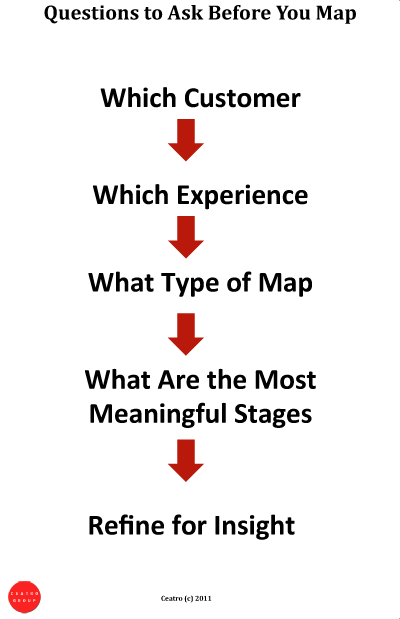 Mapping your customers’ experiences and documenting the Customer Experience you offer to your customers is an important corporate capability. Though we believe one department should own the official, final mapping and all its scheduled updates, we also believe that every employee should practice mapping in order to better understand the customers (or employees or partners) they design for or serve.
Mapping your customers’ experiences and documenting the Customer Experience you offer to your customers is an important corporate capability. Though we believe one department should own the official, final mapping and all its scheduled updates, we also believe that every employee should practice mapping in order to better understand the customers (or employees or partners) they design for or serve.
Mapping shouldn’t be intimidating. Human understanding is core to how we as people learn to live and function in the world. Standing in your customer shoes and thinking like them is a capability that every one has – it just takes practice.
We always begin on paper or Post-It note and put all technology to the side for the first few drafts. We also believe that for the first few drafts hypotheses will do and we make notations on each “fact” to make sure we remember what was a hypothesis and what was a solid fact. We can firm up the customer insight and data later before we ever put mouse to screen.
To get started, we answer the questions – or we won’t know where to start:
-
Which customer segments are we interested in learning about?
When it comes to behavior and perception every segment is different. You won’t get far if you try to map every segment’s experience all at once because when you aggregate the experiences together you won’t be able to see nuances that will expose the opportunities to improve the experience (and satisfaction, revenue, etc.) If you don’t know where to start map the segment that has the most value to your organization (however you choose to define value.)
-
Which of the customers’ experiences will be mapped?
Which experience do you want to learn about? Unless you are hunting down a specific problem in the customer experience, we like to do our maps from the top down: the overarching experience, the stage level experience, action or decision level experiences, and then the touch point experiences. These nested experience levels can be seen
here. This is a longer effort so if you are, for example, trying to find a problem that is causing customers to cancel business contracts one week before renewal then you should start by mapping their renewal experience and then their product-use experience and then their context map for both (renewal problems often have long legs and don’t necessarily start where you think they do.)
-
What type of map do you need?
We want you to map everything . . . but that isn’t always practical in the time you have available. You will need to determine what is the most important insight for the results you need, start by mapping that insight, and then add the rest in as you go along. In this context we are referring to emotions, behaviors, attitudes. actions, tasks, decisions, touchpoints, and any other relevant element as “insights.” We don’t know how to create a map without using the actions, decisions, and touchpoints as scaffolding. Then we layer on emotions, behaviors, and attitudes. We then often layer on error-paths or alternative choices depending on what we are trying to solve or design. You may be able to get away with just actions and touchpoints if you are, for example, trying to solve or improve a process that keeps causing customers to fail. If you know, however, that you are specifically trying to figure out why your customers leave the majority call center experience feeling disrespected you automatically know you need emotions and attitudes in your map.
-
What are the most meaningful stages?
This is a map from the customers’ perspective. You should only use customer oriented language on the map (nouns and verbs customers would use, not words an organization would use). Customers don’t think in terms of the stages of their experience with your organization or your offering but you need to break up the map into manageable parts or the information will get overwhelming. We have tried to map without stages and the map just became unmanageable and incomprehensible in the end. In order to come up with the stages you will use on the map we recommend thinking about all the things you think this customer segment does to achieve their goal and then group them together in meaningful groups (or stages). These stages, and their names, should be understandable to customers, in customer language.[“Attract” and “Capture”, typical on Customer Experience maps that depict what an organization offers to its customers (Inside-Out Maps) are not customer language; it is corporate language,] and give readers of the map aid in understanding the information. Expect that you will change the stages and their names a few times as you create more drafts of the map until you feel you get them right.
-
How much insight is enough?
Iterate. Iterate. Iterate. Mapping your customers’ experience is something everyone can and should do to gain understanding about what is actually going on in their customers’ world. As we mentioned in the beginning, mapping is a matter of creating draft with hypotheses, then gaining more insights and refining until you get a map that you and your colleagues feels is accurate and informative. It is always better to have more information than you need for the project you are working on. Once we move from paper we make sure we log all of our insights either in an Excel workbook or another database in case we remove elements and data from the map during the iterations.

 Mapping your customers’ experiences and documenting the Customer Experience you offer to your customers is an important corporate capability. Though we believe one department should own the official, final mapping and all its scheduled updates, we also believe that every employee should practice mapping in order to better understand the customers (or employees or partners) they design for or serve.
Mapping your customers’ experiences and documenting the Customer Experience you offer to your customers is an important corporate capability. Though we believe one department should own the official, final mapping and all its scheduled updates, we also believe that every employee should practice mapping in order to better understand the customers (or employees or partners) they design for or serve.
